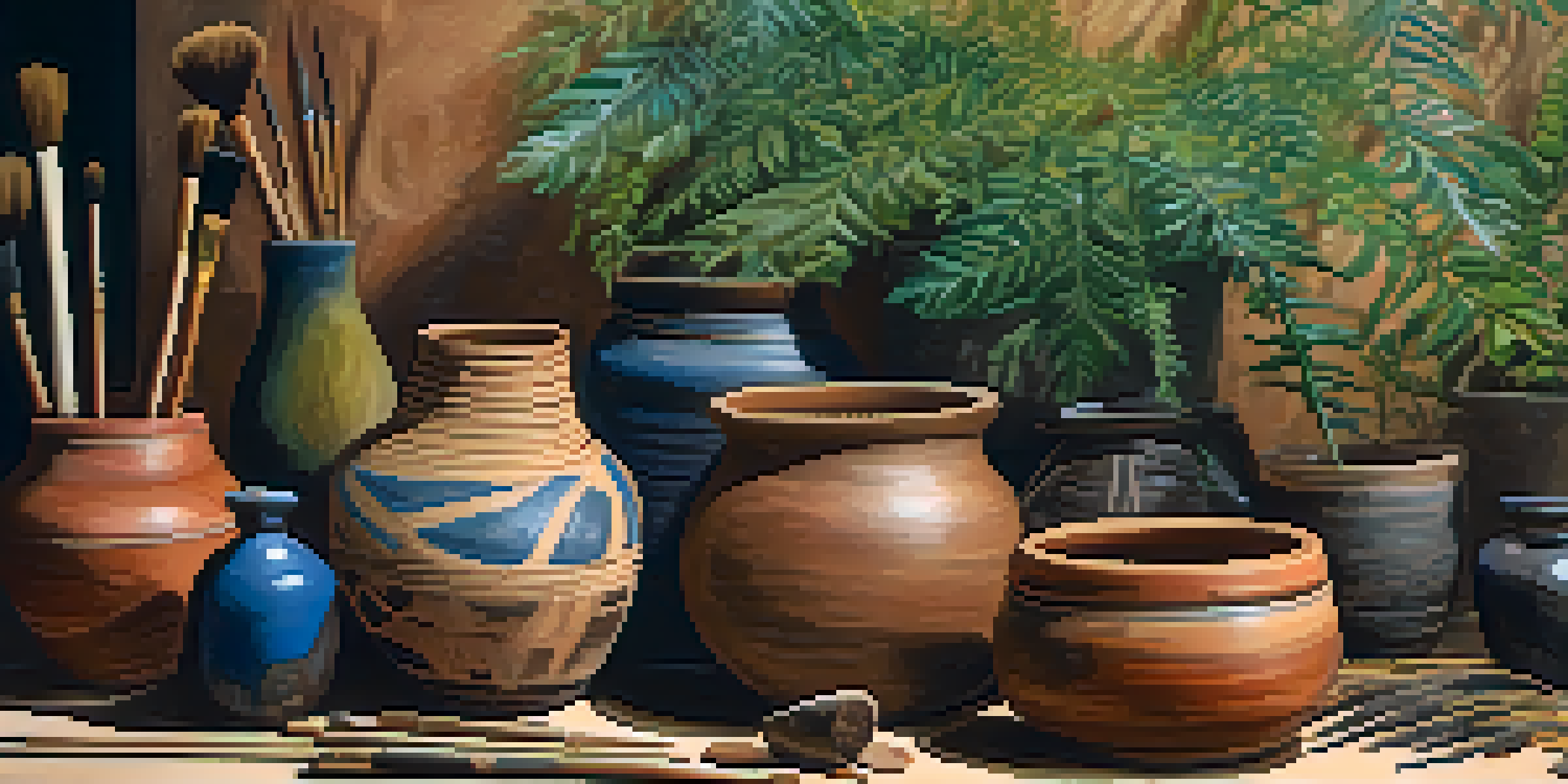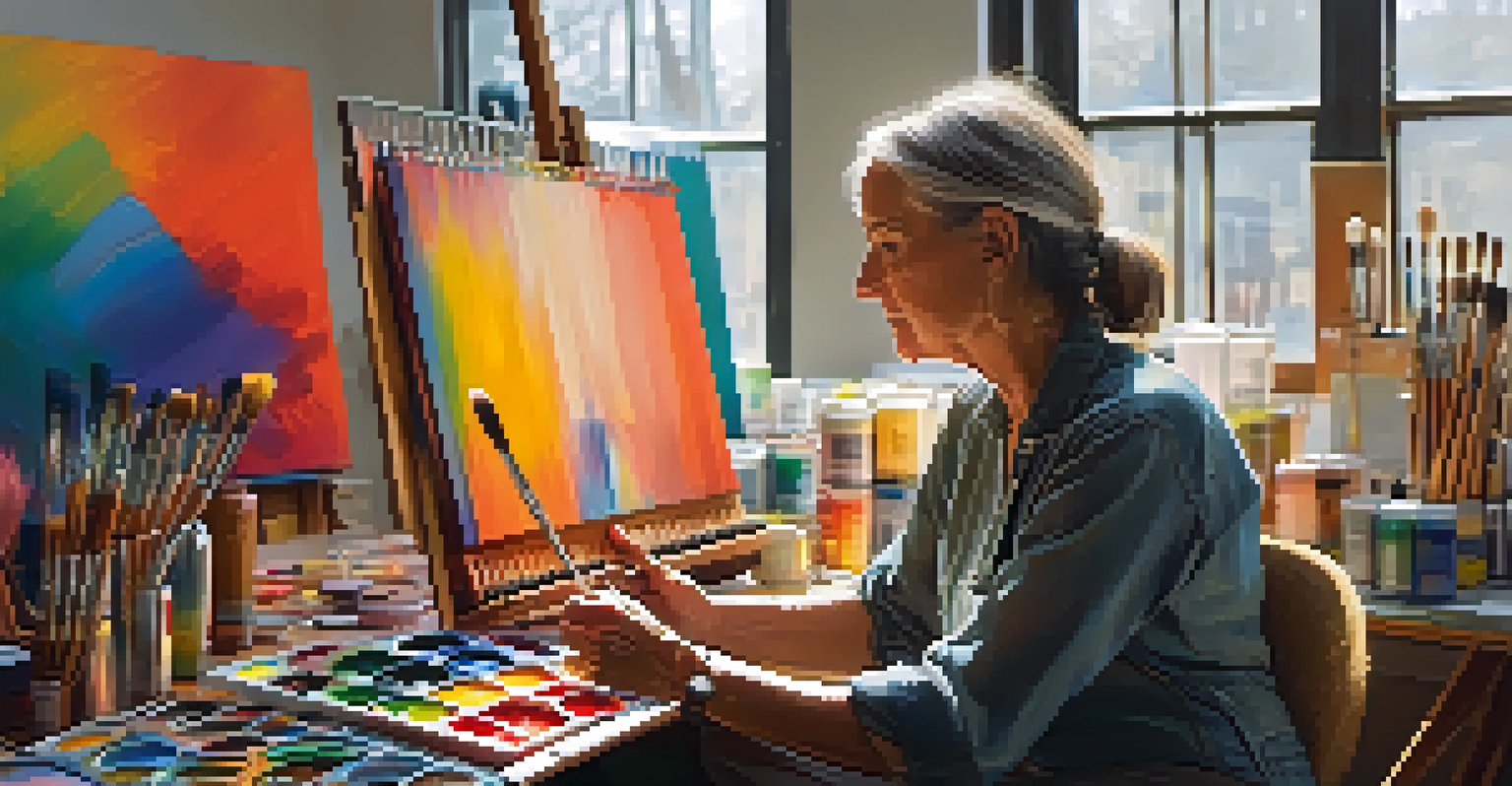The Transition from Natural to Synthetic Painting Tools

The Roots of Natural Painting Tools
Natural painting tools have a rich history, dating back to early humans who used materials like charcoal and ochre. These tools were not just instruments; they were closely tied to the environment and culture. For instance, artists in Aboriginal cultures utilized clay and plant-based pigments, showcasing a deep connection to nature. This reliance on natural resources not only fostered creativity but also reflected the artists' surroundings.
Art is the most beautiful of all lies.
As civilizations evolved, so did the materials used for painting. The Renaissance period saw the emergence of more refined natural tools, such as brushes made from animal hair and paints derived from minerals and plants. These advancements allowed for greater detail and vibrancy in artwork, paving the way for iconic masterpieces. Artists began to experiment, leading to unique styles and techniques that enriched the art world.
However, while natural tools were widely embraced, they also had limitations in terms of availability and consistency. For example, the quality of natural pigments could vary significantly, impacting the final artwork. As artists sought greater control and reliability, the stage was set for a transition to synthetic materials.
The Dawn of Synthetic Painting Tools
The transition to synthetic painting tools began in the 19th century, driven by the Industrial Revolution and advancements in chemistry. This era introduced synthetic pigments, which offered a wider color palette and improved durability compared to their natural counterparts. Artists quickly embraced these innovations, leading to breakthroughs in various art movements, such as Impressionism and Modernism.

One significant advantage of synthetic tools was their consistency. Unlike natural pigments, which could vary in hue and texture, synthetic colors were produced in controlled environments. This reliability allowed artists to achieve predictable results, fostering experimentation and creativity. Imagine an artist who could replicate the same vibrant blue every time—this reliability opened new doors for artistic expression.
Natural Tools Shaped Artistic Culture
Early painting tools, rooted in nature, fostered a deep connection between artists and their environments.
Synthetic brushes also emerged during this period, made from materials like nylon and polyester. These brushes offered different textures and stiffness levels, catering to various painting techniques. The combination of synthetic pigments and brushes revolutionized the art world, enabling artists to explore new styles and push boundaries.
The Benefits of Synthetic Tools
Synthetic painting tools come with a host of benefits that have endeared them to many artists. One of the most notable advantages is their longevity; synthetic paints are often more resistant to fading and environmental factors than natural ones. This means that artworks can maintain their vibrancy for much longer, preserving the artist's vision for future generations.
The painter tries to master light, but light is the master of the painter.
Another benefit lies in the accessibility of these tools. Synthetic materials can be produced in bulk, making them widely available and often more affordable than natural alternatives. This democratization of art supplies means that aspiring artists, regardless of their background, can access high-quality tools to express their creativity. It's like having a toolbox that's always stocked with the best gear.
Moreover, the versatility of synthetic tools cannot be overstated. They can be used on various surfaces, from canvas and wood to paper and even fabric. This adaptability allows artists to explore mixed media techniques, merging different styles and materials to create unique works of art. The synthetic revolution has indeed expanded the horizons of artistic possibility.
Environmental Considerations
As the popularity of synthetic painting tools grew, so did concerns about their environmental impact. Many synthetic materials are derived from petroleum-based products, raising questions about sustainability in the art supply industry. Artists and consumers alike began to consider the ecological footprint of their choices, leading to a demand for more eco-friendly options.
Fortunately, the industry has responded with innovations in sustainable art supplies. Many companies now offer synthetic tools made from recycled materials or plant-based sources. This shift not only addresses environmental concerns but also appeals to a growing demographic of eco-conscious artists. Think of it as a way to paint with a purpose, where every brushstroke contributes to a healthier planet.
Synthetic Tools Revolutionized Art
The introduction of synthetic painting materials expanded color options and consistency, enabling new artistic techniques.
Additionally, the conversation around sustainability has sparked a renewed interest in natural materials among some artists. While synthetic tools offer many advantages, the allure of traditional methods and materials remains strong. This duality creates an exciting dynamic in the art world, where artists can choose to honor both modern innovations and historical practices.
Artistic Expression with Synthetic Tools
The ability to use synthetic tools has significantly influenced artistic expression. With a vast array of colors and textures at their disposal, artists can explore new styles and techniques that were previously unimaginable. For instance, the smooth application of acrylic paints allows for rapid layering, enabling artists to create stunning visual effects in a fraction of the time.
Moreover, synthetic tools have facilitated the rise of digital art. With the advent of graphic tablets and software, artists can replicate the feel of painting with synthetic brushes while benefiting from digital versatility. This blend of traditional and modern techniques has birthed a new era of creativity, where boundaries between different art forms are blurred.
Artists today often find inspiration from the endless possibilities that synthetic tools provide. Whether it’s experimenting with mixed media or diving into the world of digital art, the transition to synthetic tools has empowered creators to push their limits. This evolution not only enriches the art community but also inspires future generations of artists to innovate and express themselves.
The Future of Painting Tools
As we look ahead, the future of painting tools promises even more exciting innovations. With continuous advancements in technology and materials science, we can expect to see further enhancements in synthetic tools that prioritize both performance and sustainability. Imagine a brush that self-cleans or paint that changes color based on lighting conditions—these concepts are becoming more feasible.
Additionally, the blending of traditional and synthetic methods might lead to a renaissance of unique art forms. Artists are increasingly experimenting with combining natural materials with synthetic counterparts to create hybrid works that celebrate both worlds. This trend reflects a broader desire to connect with nature while harnessing the benefits of modern technology.
Sustainability in Art Supplies Matters
Growing environmental concerns have led to innovations in eco-friendly art tools, balancing modern needs with ecological responsibility.
Ultimately, the transition from natural to synthetic painting tools marks a significant chapter in the art world. It showcases how innovation can drive creativity while also encouraging artists to remain mindful of their impact on the environment. As we embrace the future, the possibilities for artistic expression are boundless, ensuring that art will continue to evolve and inspire.
Conclusion: Embracing Change in Art
The journey from natural to synthetic painting tools is a testament to the evolution of artistry. While natural tools have their charm and history, the advancements offered by synthetic materials have transformed the landscape of creative expression. Artists now have access to tools that not only enhance their capabilities but also reflect a changing world.
This transition highlights the importance of adaptability in art. Embracing change allows artists to explore new mediums and techniques, ultimately enriching their practice. It's a reminder that creativity thrives on experimentation and evolution, much like the art forms themselves.

As we celebrate this evolution, it's essential to recognize that every artist's journey is unique. Whether one prefers the roots of natural tools or the innovations of synthetic options, the heart of artistry remains the same—expressing thoughts, emotions, and experiences through the power of paint. The canvas is wide open, waiting for the next stroke of inspiration.